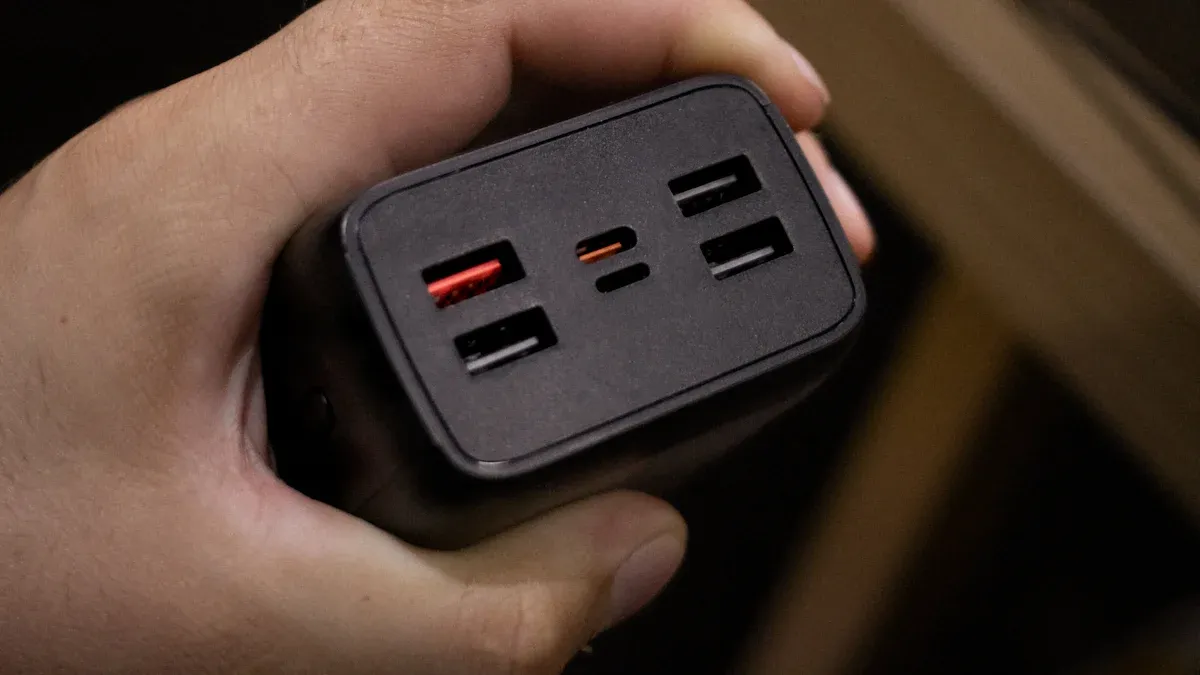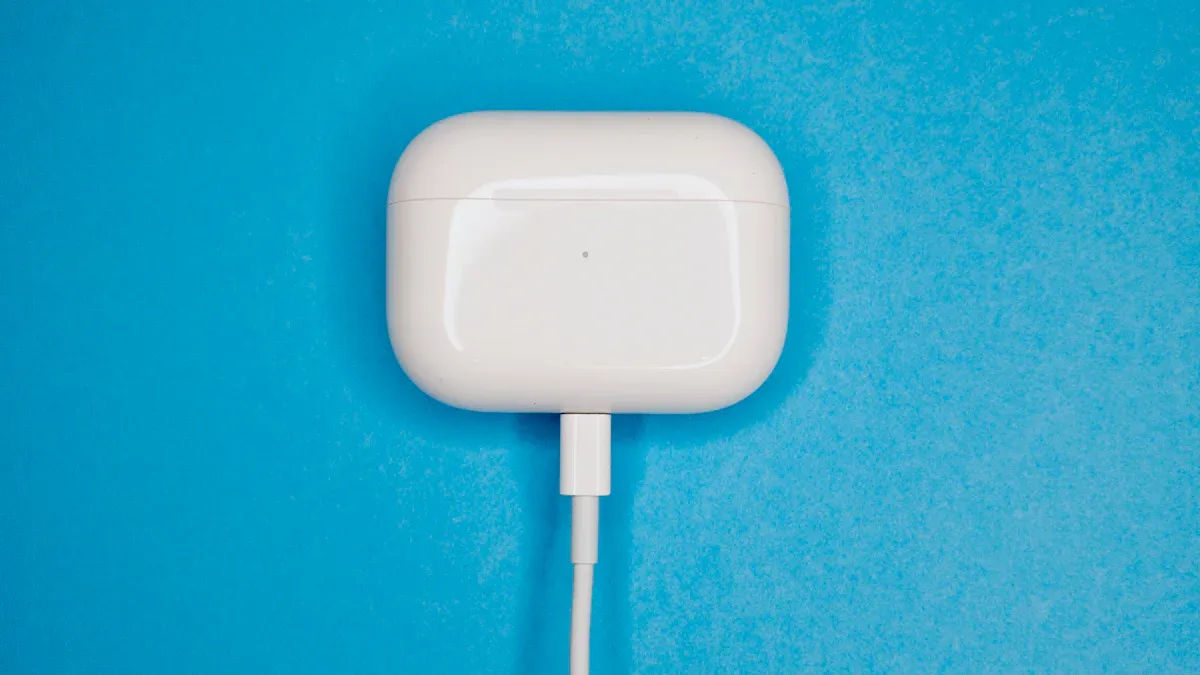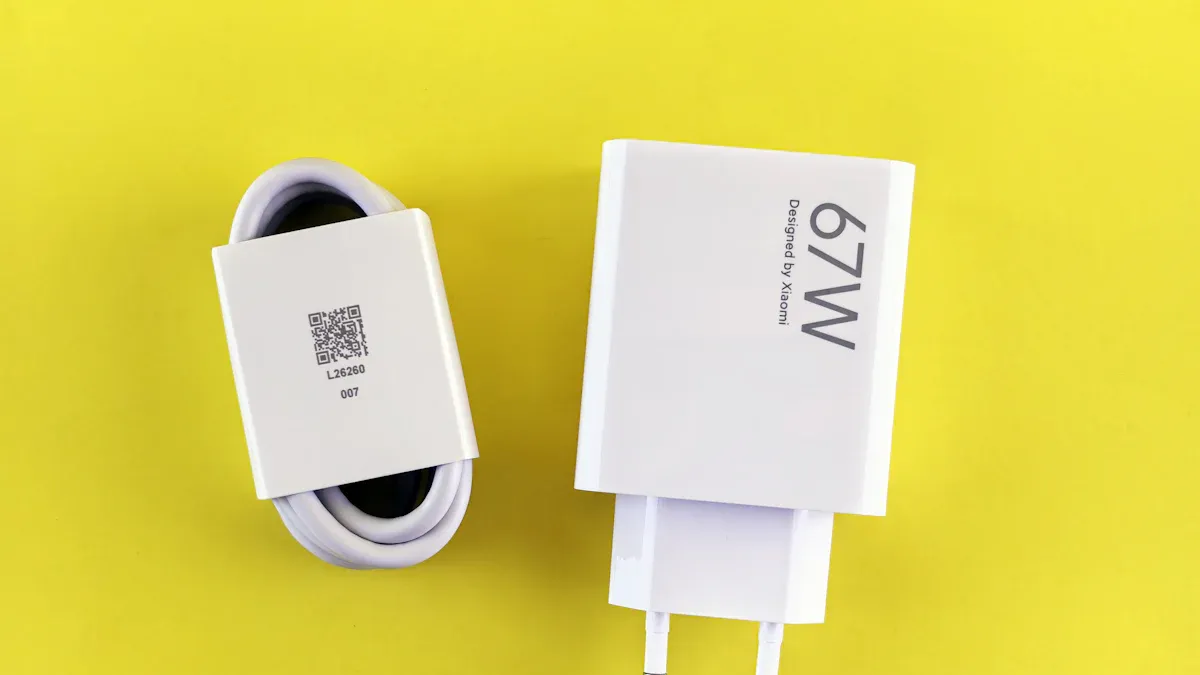Understanding phone charger types is crucial for ensuring compatibility between your devices and chargers. With various options available, including USB-A, USB-C, Lightning, and more, each type serves specific needs.
- The mobile phone charger market consists of wired and wireless chargers.
- Wired chargers dominate the market, driven by advancements in USB technology.
- These chargers cater to smartphones, tablets, and other mobile devices.
Choosing the right connector, such as USB-C for Android or Lightning for Apple devices, ensures safe and efficient charging. As smartphones evolve, selecting a future-proof plug becomes even more important.
USB-A: The Classic Phone Charger Plug
Features and Compatibility
USB-A is one of the most widely recognized phone charger types. You’ve likely encountered this plug in countless devices, from smartphones to tablets and even gaming consoles. Its rectangular design makes it easy to identify, though it only fits one way into a port. This can sometimes make connecting a bit tricky.
USB-A plugs are highly versatile. They connect to various devices, including those with AB receptacles, which accept both A and B plugs. The A plug typically connects upstream to a host device, such as a computer or wall adapter, while the B plug connects downstream to peripherals like printers or external drives. The table below highlights key technical specifications that ensure compatibility across different types of chargers:
| Specification | Description |
|---|---|
| Connector Types | USB-A plugs connect to devices with AB receptacles, accepting both A and B plugs. |
| Upstream/Downstream Functionality | The A plug connects upstream to a host, while the B plug connects downstream to peripherals. |
| Compatibility with Standards | USB standards ensure cables have specific plug combinations for device compatibility. |
This compatibility makes USB-A a reliable choice for many charging needs, though newer options like USB-C are gaining popularity.
Charging Speed Limitations
While USB-A chargers remain common, they have notable speed limitations. These chargers typically provide a maximum output of 5V/2.4A, which equals about 12 watts. This is sufficient for basic charging but falls short compared to newer, high-wattage chargers. Here are some key points about USB-A charging speeds:
- USB-A chargers deliver slower charging compared to USB-C or other advanced options.
- They are ideal for standard charging needs but may not support fast charging technologies.
- If you use a USB-A charging cable, expect baseline speeds rather than rapid power delivery.
Although USB-A chargers are reliable, they may not meet the demands of modern devices requiring faster charging. For better performance, you might consider exploring different types of USB cables, such as USB-C, which offer improved speed and efficiency.
USB-C: The Future of Phone Charger Types
Reversible Design and Benefits
USB-C has revolutionized the way you connect and charge your devices. One of its standout features is its reversible design. Unlike older USB plugs, which only fit one way, USB-C connectors are symmetrical. This means you can insert the plug without worrying about the orientation. No more fumbling to find the correct side—just plug it in and go.
This design not only simplifies your experience but also reduces wear and tear on both the cable and the port. Over time, this can extend the lifespan of your devices. The convenience of USB-C aligns with modern consumer demands for hassle-free technology. It’s no surprise that this feature has contributed to its widespread adoption across various devices, from smartphones to laptops.
Governments and organizations are also recognizing the benefits of USB-C. For example, the European Parliament has mandated that all mobile devices sold in the EU must feature USB-C ports by 2024. This initiative promotes universal charging solutions, making it easier for you to use a single cable for multiple devices. It also helps reduce electronic waste, a growing concern in today’s tech-driven world.
Fast Charging and Data Transfer
When it comes to charging, USB-C stands out for its speed and efficiency. USB-C chargers support advanced technologies like Power Delivery (PD) and Quick Charge, which allow for faster charging compared to older USB standards. With a USB-C charging cable, you can power up your device significantly quicker. For instance, USB-C Power Delivery can deliver up to 100 watts of power, making it ideal for not just phones but also tablets and laptops.
Here are some key advantages of USB-C fast charging:
– It uses higher current or voltage to charge devices more quickly.
– Smart chips in the cable ensure safe power transfer, protecting your device from overcharging.
– Charging speeds are approximately 70% faster than standard 5W chargers.
USB-C isn’t just about charging—it’s also a game-changer for data transfer. With USB 3.1, 3.2, and USB4 protocols, USB-C cables can achieve incredible speeds. For example, USB4 supports data transfer rates of up to 80 Gbps. This makes it perfect for transferring large files, such as high-resolution videos, in seconds. The table below highlights the data transfer rates of different USB standards:
| Standard | Data Transfer Rate |
|---|---|
| USB 3.1 | 10 Gbps |
| USB 3.2 | Up to 40 Gbps |
| USB4 | Up to 80 Gbps |
These speeds are ideal for modern workflows, where efficiency is key. Whether you’re backing up your phone or transferring files between devices, USB-C ensures you get the job done quickly and reliably.
The growing popularity of USB-C is also driven by its compatibility with high-end devices. As premium smartphones and laptops adopt this standard, USB-C is becoming the go-to choice for consumers worldwide. Its ability to combine fast charging and high-speed data transfer in a single cable makes it a versatile and future-proof option.
Lightning: Apple’s Exclusive Charging Solution
Compatibility with Apple Devices
The Lightning connector is Apple’s proprietary solution for charging and data transfer. It works exclusively with Apple devices, including iPhones, iPads, and certain accessories like AirPods. If you own an iPhone, you’ve likely used a Lightning charger to power your device or sync data. This exclusivity ensures seamless integration within the Apple ecosystem, making it a reliable choice for users of Apple products.
Apple’s dominance in the smartphone market drives the widespread use of Lightning chargers.
– Around 50% of smartphone users in the U.S. own iPhones, creating high demand for Lightning cables.
– Globally, Apple holds approximately 47% of smartphone sales as of Q2 2023.
– Many users purchase multiple charging accessories, including Lightning to USB cables, to meet their needs.
This popularity highlights the importance of Lightning chargers for Apple users. However, if you use non-Apple devices, you’ll need adapters to connect Lightning cables to other gadgets.
Advantages and Drawbacks
Lightning chargers offer several benefits that enhance your experience with Apple devices.
1. Advantages:
– The reversible design makes plugging in effortless.
– Strict certification ensures reliability and durability.
– Seamless compatibility with Apple devices simplifies charging and data transfer.
- Drawbacks:
- Lightning chargers work only with Apple devices, limiting their versatility.
- They cost more than alternatives like USB-C cables.
Comparative studies also highlight key differences between Lightning and other connectors:
| Aspect | Lightning Connector | MicroUSB Connector |
|---|---|---|
| Durability | Less prone to bending, more robust | More prone to wear and tear |
| User-Friendliness | Reversible design, easy to use | Can be plugged in only one way |
| Compatibility | Limited to Apple devices without adapters | Widely used across various devices |
| Cost | Generally more expensive due to proprietary nature | Typically cheaper and more accessible |
While Lightning chargers excel in user-friendliness and reliability, their proprietary nature and higher cost may make you consider alternatives like USB-C, especially if you use multiple devices.
Other Phone Charger Types: Micro-USB and USB-B
Micro-USB: Features and Use Cases
Micro-USB was once the standard for many devices, including smartphones and tablets. Its compact design made it a popular choice for manufacturers. You can still find Micro-USB in external power supplies for mobile phones, showing its continued relevance. Many older devices, such as cameras and Bluetooth speakers, also rely on this connector.
One of the key features of Micro-USB is its small size, which allows it to fit into slim devices. However, it only connects in one orientation, which can make plugging it in less convenient compared to newer options like USB-C. Despite this limitation, Micro-USB remains a cost-effective solution for basic charging needs. If you own older gadgets, you likely have a few Micro-USB cables lying around.
USB-B: Niche Applications
USB-B connectors serve a more specialized purpose. You’ll often find them in peripheral devices like printers, routers, and photocopying machines. These connectors are larger and more robust, making them ideal for stationary equipment that doesn’t require frequent plugging and unplugging.
Although USB-B is not as common as other phone charger types, it remains relevant in specific markets. For example, many office environments still use USB-B for connecting printers and scanners. Its durability and reliability make it a practical choice for these applications. If you work with such devices, you’ve likely encountered USB-B cables.
Both Micro-USB and USB-B highlight the diversity of different types of USB cables. While newer technologies like USB-C dominate the market, these older connectors continue to play a role in specific use cases. Understanding their features can help you choose the right charger for your needs.
Emerging Technologies in Charging
Wireless Charging: Convenience and Compatibility
Wireless charging has transformed the way you power your devices. Instead of dealing with tangled cables, you can simply place your phone or tablet on a wireless charger to start charging instantly. This technology uses electromagnetic fields to transfer energy between the charging pad and your device, eliminating the need for physical connectors.
The convenience of wireless charging is undeniable. You no longer need to search for the right cable or worry about wear and tear on charging ports. With the Qi standard, wireless chargers are compatible with a wide range of devices, including smartphones, tablets, and even wearables. This means you can use a single wireless charger for multiple gadgets, simplifying your charging setup.
Here are some key benefits of wireless charging:
– It eliminates the hassle of cables, allowing you to charge your device by simply placing it on the pad.
– The Qi standard ensures compatibility across various brands and models.
– It enhances efficiency by reducing the time spent searching for cables or dealing with damaged ports.
The adoption of wireless charging is growing rapidly. The global wireless charging market is expected to expand from USD 6.4 billion in 2024 to USD 16.0 billion by 2029, with a compound annual growth rate (CAGR) of 20.3%. This growth is driven by the increasing integration of wireless charging in smartphones, tablets, and wearables, as well as the rising popularity of electric vehicles equipped with wireless charging capabilities.
While wireless charging offers unmatched convenience, it’s important to consider its limitations. Charging speeds are generally slower compared to wired options like USB-C. However, as technology advances, wireless charging is becoming faster and more efficient, making it a promising solution for the future.
Fast Charging Standards: Power Delivery and Quick Charge
Fast charging standards like Power Delivery and Quick Charge have revolutionized how quickly you can power up your devices. These technologies allow chargers to deliver higher levels of power, significantly reducing the time it takes to charge your phone, tablet, or laptop.
Power Delivery is one of the most advanced fast charging standards. It can deliver up to 100 watts of power, making it suitable for a wide range of devices, from smartphones to laptops. This system-wide approach uses compatible wall adapters that provide increased electrical current and voltage, ensuring efficient charging. Sophisticated chips in your device regulate the incoming electricity, protecting it from overcharging or overheating.
Quick Charge, another popular standard, is known for its speed. With Quick Charge, you can power your device up to 50% in just 30 minutes. This makes it an excellent choice when you’re short on time and need a quick boost.
The table below highlights the key features of fast charging standards:
| Feature | Description |
|---|---|
| Charging Speed | Fast charging standards like USB Power Delivery can charge devices significantly faster, with up to 100 watts of power delivery. |
| System-wide Approach | These standards utilize compatible wall adapters that provide increased electrical current and voltage, ensuring efficient charging. |
| Device Regulation | Sophisticated chips in devices manage the incoming electricity, allowing for safe and rapid charging. |
| Quick Charge Capability | Devices can achieve up to 50% charge in just 30 minutes, demonstrating the effectiveness of these standards. |
Fast charging is not just about speed; it’s also about safety and efficiency. The smart chips in fast chargers ensure that your device receives the right amount of power, preventing damage to the battery. This makes fast charging a reliable and future-proof option for modern devices.
When comparing future-proof charging solutions, both USB-C and wireless charging have their strengths. USB-C offers universal compatibility and high-speed charging, while wireless charging provides unmatched convenience. The table below compares these two technologies:
| Criteria | USB-C Charging Solutions | Wireless Charging Technologies |
|---|---|---|
| Interoperability | All devices will use a common USB-C port, enhancing compatibility. | Requires standardization to ensure compatibility across devices. |
| Environmental Benefits | Reduces e-waste by minimizing the number of chargers needed. | Potentially increases e-waste if not standardized. |
| Consumer Choice | Consumers can choose devices without chargers, promoting flexibility. | Limited choice if proprietary systems dominate. |
| Innovation | Encourages development of new charging technologies. | Innovation may be stifled without regulatory support. |
Fast charging standards like Power Delivery and Quick Charge are shaping the future of charging technology. They offer a perfect balance of speed, safety, and efficiency, making them an essential feature for modern devices.
Understanding the differences between phone charger types helps you make informed decisions. The table below summarizes key features and pros/cons of popular options:
| Charger Type | Key Features | Advantages/Disadvantages |
|---|---|---|
| USB Type-A | Rectangular, fits one way. | Reliable but outdated. |
| USB Type-B | Square-like, used for larger devices. | Durable but less common. |
| USB Type-C | Reversible, fast charging and data transfer. | Widely adopted, future-proof. |
| Lightning Charger | Apple-exclusive, connects to peripherals. | Essential for Apple users, limited compatibility. |
| Micro-USB Charger | Compact, used in older Android devices. | Affordable but losing popularity. |
When choosing a charger, prioritize compatibility with your device. For modern gadgets, USB-C offers fast charging, high-speed data transfer, and universal use. Wireless charging adds convenience, especially for multiple devices. Opting for these future-proof solutions ensures efficiency and reduces e-waste.
FAQ
1. Can you use a USB-C charger for older devices?
No, older devices with Micro-USB ports need adapters to connect to USB-C chargers. Check your device’s port type before purchasing a charger.
2. Is wireless charging slower than wired charging?
Yes, wireless charging is generally slower than USB-C fast charging. However, it offers convenience by eliminating cables and reducing wear on charging ports.
3. Do Lightning cables work with non-Apple devices?
Lightning cables only work with Apple devices. You need adapters to connect them to non-Apple gadgets, which limits their compatibility.



